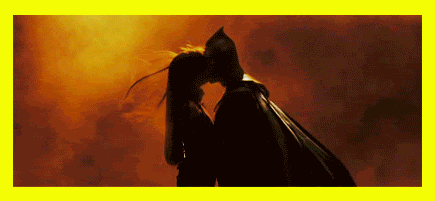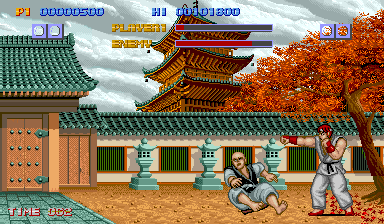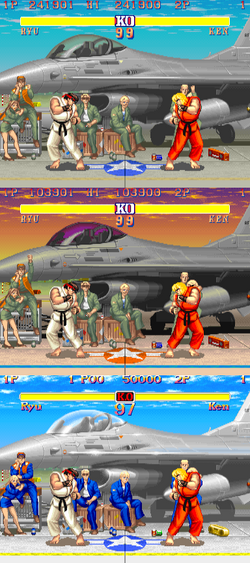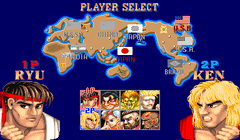"Rorschach's Journal October 12th, 1985: Dog carcass in alley this-morning, tire tread on burst stomach. This city is afraid of me. I have seen its true face." These are the famous opening words of probably the single most important sequential artwork story produced in the latter half of the twentieth century.
 |
| Tonight a comedian died in New York. |
Watchmen by Alan Moore and Dave Gibbons is as far as I'm concerned, the finest piece of comic book story telling in print on this planet. Watchmen is set in 1985, in an alternate history United States where costumed adventurers are real and the country is edging closer to a nuclear war with the Soviet Union (the Doomsday Clock is at five minutes to midnight). It tells the story of a group of past and present superheroes and the events surrounding the mysterious murder of one of their own. Watchmen depicts superheroes as real people who must confront ethical and personal issues, who struggle with neuroses and failings, and who (with one notable exception) lack anything recognizable as super powers. Watchmen's conventional superhero archetype, combined with its innovative adaptation of cinematic techniques and heavy use of symbolism, multi-layered dialogue, and meta-fiction, has influenced both comics and film.
| Rorschach By Dave Gibbons. |
The story begins with the murder of one such former hero (though I use the word loosely): The Comedian. This attracts the attention of one of his former team-mates Rorschach, a character who is the embodiment of faceless vigilante justice. Rorschach starts an investigation into what he believes is a "Cape Killer", an investigation which will lead him not only to his former retired team-mates but into a conspiracy to bring about a new world order through the atomic fire of all out nuclear war between the global superpower states. The world Watchmen inhabits is often what I feel allowed the book to set itself apart from other superhero stories. It is a world that is given a sense of seriousness and grounded reality through the inclusion of real life historical events, and how the characters of this world fit into those events such as the Kennedy Assassination and the Vietnam War. This allows the reader to be truly enveloped by the story as you get a sense that this could actually have happened.
Publication.
Originally published by DC Comics as a monthly limited series from 1986 to 1987, it was later republished as a trade paperback, which popularized the "graphic novel" format. To date, Watchmen remains the only graphic novel to win a Hugo Award, and is also the only graphic novel to appear on Time magazine's 2005 list of "the 100 best English-language novels from 1923 to the present".
Alan Moore, who wanted to transcend the perceptions of the comic book medium as something juvenile, created Watchmen as an attempt to make "a superhero Moby-Dick; something that had that sort of weight, that sort of density." Moore also named William S. Burroughs as one of his "main influences" during the conception of Watchmen and admired Burroughs' use of "repeated symbols that would become laden with meaning" in Burroughs's one and only comic strip, The Unspeakable Mr. Hart, which appeared in the British underground magazine Cyclops.
 |
| The Watchmen By Dave Gibbons. |
Moore and Gibbons originally conceived of a story that would take "familiar old-fashioned superheroes into a completely new realm." Initially, Moore looked towards the defunct MLJ Comics line of superheroes for inspiration. "I'd just started thinking about using the MLJ characters — the Archie super-heroes - just because they weren't being published at that time, and for all I knew, they might've been up for grabs. The initial concept would've had the 1960s-'70s rather lame version of the Shield being found dead in the harbour, and then you'd probably have various other characters, including Jack Kirby's Private Strong, being drafted back in, and a murder mystery unfolding. I suppose I was just thinking, 'That'd be a good way to start a comic book: have a famous superhero found dead.' As the mystery unravelled, we would be led deeper and deeper into the real heart of this superhero's world, and shown a reality that was very different to the general public image of the superhero. So, that was the idea."
 | |
| The Charton Comics Characters. |
Reception Upon Release.
Watchmen was published in single-issue form over the course of 1986 and 1987. The miniseries was a commercial success, and its sales helped DC Comics briefly overtake its competitor Marvel Comics in the comic book direct market. Watchmen also received several awards spanning different categories and genres including: Kirby Awards for Best Finite Series, Best New Series, Best Writer, and Best Writer/Artist; Eisner Awards for Best Finite Series, Best Graphic Album, Best Writer, and Best Writer/Artist; and a Hugo Award for Other Forms.
Watchmen received praise from those working within the comic book industry, as well as external reviewers, for its avant-garde portrayal of the traditional superhero. Watchmen became known as a novel which allowed the comic book to be recognized as "great art", rather than a lowbrow or unsophisticated genre. Time magazine, which noted that the series was "by common assent the best of breed" of the new wave of comics published at the time, praised Watchmen as "a superlative feat of imagination, combining sci-fi, political satire, knowing evocations of comics past and bold re-workings of current graphic formats into a dystopian mystery story." Don Markstein of Toonopedia wrote that, "What The Maltese Falcon did for detective stories and Shane did for westerns, Watchmen did for superheroes. It transcended its origins in what was previously considered a lowbrow form of fiction."
 | |
| Rorschach's Mask. |
Watchmen's status as a seminal book in the comic book field was recently boosted when acclaimed comic book author Stan Lee, responsible for creating the majority of Marvel Comics' most successful characters, called it his "all-time favourite comic book outside of Marvel." A review by "Revolution SF" goes on to say that Watchmen is "one of the most important stories in comic book history". Moore himself acknowledged that the plot closely resembles an Outer Limits episode called "The Architects of Fear". According to him, while he was around issue 10, he came across a guide to cult television that featured this episode and was surprised by its similarity to his already planned ending. A belated nod to "The Architects of Fear" is made near the end of Watchmen . He also accepted responsibility for the proliferation of "dark" comic stories, featuring classic characters, that followed Watchmen. In his review of the Absolute edition of the collection, Dave Itzkoff of The New York Times wrote that the dark legacy of Watchmen, "one that Moore almost certainly never intended, whose DNA is encoded in the increasingly black inks and bleak storylines that have become the essential elements of the contemporary superhero comic book," is "a domain he has largely ceded to writers and artists who share his fascination with brutality but not his interest in its consequences, his eagerness to tear down old boundaries but not his drive to find new ones".
Watchmen The Motion Picture
 |
| 2009 - Watchmen - Movie Poster. |
The film is well cast with Jackie Earle Haley as Walter Kovacs (Rorschach), Billy Crudup as Jon Osterman (Dr. Manhattan), Jeffrey Dean Morgan as Eddie Blake (The Comedian), Patrick Wilson as Dan Dreiberg (Nite Owl II), Malin Akerman as Laurie Juspeczyk (Silk Spectre II), Matthew Goode as Adrian Veidt (Ozymandias), Carla Gugino as Sally Jupiter (Silk Spectre I) and Stephen McHattie as Hollis Mason (Nite Owl I).
Go watch it and judge for yourself. Though don't expect to see Alan Moore's name anywhere in the credits. He quite publicly distanced himself from any and all film adaptations of his written works.
 | |
| Silk Spectre & Nite Owl |
Before Watchmen - Prequel Comics 2012
Following months of rumours about a potential Watchmen follow-up project, in February 2012 DC announced it was publishing seven prequel limited series under the "Before Watchmen" banner: Rorschach, Minutemen, Dr. Manhattan, Comedian, Silk Spectre, Nite Owl, and Ozymandias. Among the creators involved are writers J. Michael Straczynski, Brian Azzarello, Darwyn Cooke, and Len Wein, and artists Lee Bermejo, J. G. Jones, Adam Hughes, Andy Kubert, Joe Kubert, and Amanda Conner. Each issue would feature an instalment of the backup series "Curse of the Crimson Corsair", written by Len Wein and featuring art by original Watchmen colourist John Higgins, and the project will conclude with a Before Watchmen: Epilogue one-shot.
 |
| The Before Watchmen Promo Banner by Lee Bermago. |
Gibbons stated, "The original series of WATCHMEN is the complete story that Alan Moore and I wanted to tell. However, I appreciate DC's reasons for this initiative and the wish of the artists and writers involved to pay tribute to our work. May these new additions have the success they desire."
Moore criticized the project, calling it "completely shameless", and stated he was not interested in monetary compensation, but rather “What I want is for this not to happen.”
I really enjoyed reading the series of prequels, though I did feel that as a whole the project could not live up to the original. Go read them and judge for yourselves
Watchmen - By Nerd Invasion
To those who don't know, this week's theme - Alan Moore & Dave Gibbon's Watchmen - was chosen by Nerd Invasion's friend Darrin O'Toole (writer of Tales from
the Void, Earthruler and countless others in the future), who was the lucky
winner of our recent Facebook draw. He even went so far as to provide us
with a Ozymandias piece himself. So without further ado here's Darrin's
contribution (and kickstarter) to Watchmen week.
Ozymandias - "I don't mind being the smartest man in the world, I just wish it wasn't this one".
 |
| Ozymandias by Darrin O'Toole. |
Adrian Alexander Veidt, a.k.a. Ozymandias in the manner of Ramesses II, he is a modified version of the character Thunderbolt from Charlton Comics, and is a member of the Crimebusters. His name recalls the famous poem by Percy Bysshe Shelley, which takes as its theme the fleeting nature of empire.
Next up is Chris Duffy's contribution for Watchmen week
The Comedian - "Justice is coming to all of us".
 | ||
| The Comedian By Chris Duffy. |
Edward Morgan Blake, better known to the public as The Comedian. He is one of the only masked adventurers (along with Captain Metropolis) to be a member of both the Minutemen and the Crimebusters, and had been active for forty-five years through the aid of government-sponsored activities and the press conjuring him into a patriotic symbol of war and victory. Blake is a cigar-chomping, gun-toting vigilante turned paramilitary agent. He is described variously as "deliberately amoral" with a "practiced cynicism", meaning that he usually has little regard for social conventions or human life. Always in character as the Comedian, he describes the world as a sadistic joke that only he understands, but in the end his practiced cynicism is shattered when he discovers a plot that he regards as a "practical joke" even he can't believe anyone would pull.
Next up is Luca Pizarri's contribution for Watchmen Week
Moloch The Mystic - "And for my next trick"
 |
| Moloch The Mystic By Luca Pizarri. |
Next up is Daryl Cox's contribution for Watchmen Week
Nite Owl II - "What happened to us...what happened to the American dream?"
 | |||
| Nite Owl II By Daryl Cox. |
Daniel Dreiberg, a.k.a. Nite Owl II relied more upon technical wizardry and tools than toughness, which set him apart from his fellow costumed adventurers.
Still, he has demonstrated more than adequate skills when defending
himself. All of his gadgets and costumes are based on an owl theme. He
uses an owl-shaped flying vehicle nicknamed the "Owlship" or "Archie" (after Archimedes, Merlin's pet owl in The Sword in the Stone), equipped with a variety of offensive and defensive devices.
So I never contribute pictures as I can't draw! ... But I did dress up with some friends as the Watchmen a few years back!
 | |||||
| Dr. Manhattan - Johnny Osbourne, The Comedian - Ciarán Marcantonio, Silk Spectre - Gill Dempsey, Rorschach - Darragh Rushe. |
 |
| Gratuitous Comedian shot! |
So that's all from us here at Nerd Invasion for Watchmen Week I hope you have enjoyed it. Stay tuned to Nerd Invasions Facebook page for updates on upcoming themes. Finally here are some interesting videos so go I'll ask this final question.














